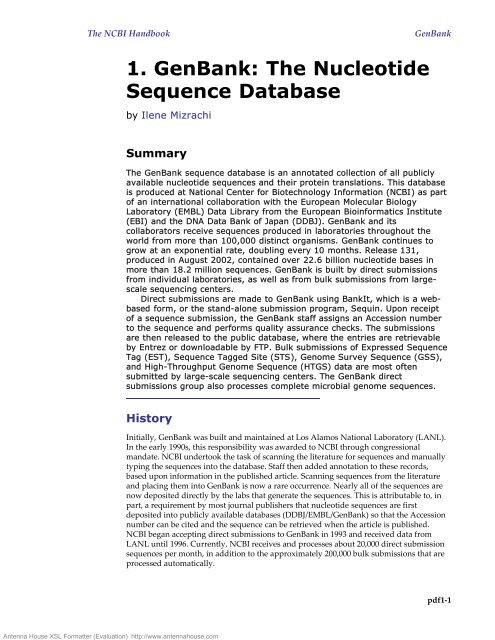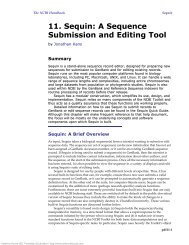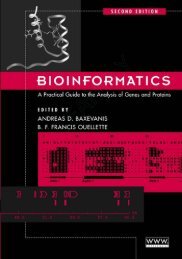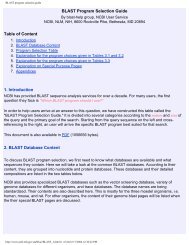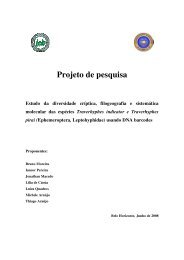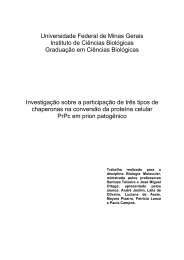1. GenBank: The Nucleotide Sequence Database
1. GenBank: The Nucleotide Sequence Database
1. GenBank: The Nucleotide Sequence Database
Create successful ePaper yourself
Turn your PDF publications into a flip-book with our unique Google optimized e-Paper software.
Antenna House XSL Formatter (Evaluation) http://www.antennahouse.com<br />
<strong>The</strong> NCBI Handbook<br />
<strong>GenBank</strong><br />
<strong>1.</strong> <strong>GenBank</strong>: <strong>The</strong> <strong>Nucleotide</strong><br />
<strong>Sequence</strong> <strong>Database</strong><br />
by Ilene Mizrachi<br />
Summary<br />
<strong>The</strong> <strong>GenBank</strong> sequence database is an annotated collection of all publicly<br />
available nucleotide sequences and their protein translations. This database<br />
is produced at National Center for Biotechnology Information (NCBI) as part<br />
of an international collaboration with the European Molecular Biology<br />
Laboratory (EMBL) Data Library from the European Bioinformatics Institute<br />
(EBI) and the DNA Data Bank of Japan (DDBJ). <strong>GenBank</strong> and its<br />
collaborators receive sequences produced in laboratories throughout the<br />
world from more than 100,000 distinct organisms. <strong>GenBank</strong> continues to<br />
grow at an exponential rate, doubling every 10 months. Release 131,<br />
produced in August 2002, contained over 22.6 billion nucleotide bases in<br />
more than 18.2 million sequences. <strong>GenBank</strong> is built by direct submissions<br />
from individual laboratories, as well as from bulk submissions from largescale<br />
sequencing centers.<br />
Direct submissions are made to <strong>GenBank</strong> using BankIt, which is a webbased<br />
form, or the stand-alone submission program, Sequin. Upon receipt<br />
of a sequence submission, the <strong>GenBank</strong> staff assigns an Accession number<br />
to the sequence and performs quality assurance checks. <strong>The</strong> submissions<br />
are then released to the public database, where the entries are retrievable<br />
by Entrez or downloadable by FTP. Bulk submissions of Expressed <strong>Sequence</strong><br />
Tag (EST), <strong>Sequence</strong> Tagged Site (STS), Genome Survey <strong>Sequence</strong> (GSS),<br />
and High-Throughput Genome <strong>Sequence</strong> (HTGS) data are most often<br />
submitted by large-scale sequencing centers. <strong>The</strong> <strong>GenBank</strong> direct<br />
submissions group also processes complete microbial genome sequences.<br />
History<br />
Initially, <strong>GenBank</strong> was built and maintained at Los Alamos National Laboratory (LANL).<br />
In the early 1990s, this responsibility was awarded to NCBI through congressional<br />
mandate. NCBI undertook the task of scanning the literature for sequences and manually<br />
typing the sequences into the database. Staff then added annotation to these records,<br />
based upon information in the published article. Scanning sequences from the literature<br />
and placing them into <strong>GenBank</strong> is now a rare occurrence. Nearly all of the sequences are<br />
now deposited directly by the labs that generate the sequences. This is attributable to, in<br />
part, a requirement by most journal publishers that nucleotide sequences are first<br />
deposited into publicly available databases (DDBJ/EMBL/<strong>GenBank</strong>) so that the Accession<br />
number can be cited and the sequence can be retrieved when the article is published.<br />
NCBI began accepting direct submissions to <strong>GenBank</strong> in 1993 and received data from<br />
LANL until 1996. Currently, NCBI receives and processes about 20,000 direct submission<br />
sequences per month, in addition to the approximately 200,000 bulk submissions that are<br />
processed automatically.<br />
pdf1-1
Antenna House XSL Formatter (Evaluation) http://www.antennahouse.com<br />
<strong>The</strong> NCBI Handbook<br />
<strong>GenBank</strong><br />
International Collaboration<br />
In the mid-1990s, the <strong>GenBank</strong> database became part of the International <strong>Nucleotide</strong><br />
<strong>Sequence</strong> <strong>Database</strong> Collaboration with the EMBL database (European Bioinformatics<br />
Institute, Hinxton, United Kingdom) and the Genome <strong>Sequence</strong> <strong>Database</strong> (GSDB; LANL,<br />
Los Alamos, NM). Subsequently, the GSDB was removed from the Collaboration (by the<br />
National Center for Genome Resources, Santa Fe, NM), and DDBJ (Mishima, Japan) joined<br />
the group. Each database has its own set of submission and retrieval tools, but the three<br />
databases exchange data daily so that all three databases should contain the same set of<br />
sequences. Members of the DDBJ, EMBL, and <strong>GenBank</strong> staff meet annually to discuss<br />
technical issues, and an international advisory board meets with the database staff to<br />
provide additional guidance. An entry can only be updated by the database that initially<br />
prepared it to avoid conflicting data at the three sites.<br />
<strong>The</strong> Collaboration created a Feature Table Definition that outlines legal features and<br />
syntax for the DDBJ, EMBL, and <strong>GenBank</strong> feature tables. <strong>The</strong> purpose of this document is<br />
to standardize annotation across the databases. <strong>The</strong> presentation and format of the data<br />
are different in the three databases, however, the underlying biological information is the<br />
same.<br />
Confidentiality of Data<br />
When scientists submit data to <strong>GenBank</strong>, they have the opportunity to keep their data<br />
confidential for a specified period of time. This helps to allay concerns that the availability<br />
of their data in <strong>GenBank</strong> before publication may compromise their work. When the article<br />
containing the citation of the sequence or its Accession number is published, the sequence<br />
record is released. <strong>The</strong> database staff request that submitters notify <strong>GenBank</strong> of the date<br />
of publication so that the sequence can be released without delay. <strong>The</strong> request to release<br />
should be sent to gb-admin@ncbi.nlm.nih.gov.<br />
Direct Submissions<br />
<strong>The</strong> typical <strong>GenBank</strong> submission consists of a single, contiguous stretch of DNA or RNA<br />
sequence with annotations. <strong>The</strong> annotations are meant to provide an adequate<br />
representation of the biological information in the record. <strong>The</strong> <strong>GenBank</strong> Feature Table<br />
Definition describes the various features and subsequent qualifiers agreed upon by the<br />
International <strong>Nucleotide</strong> <strong>Sequence</strong> <strong>Database</strong> Collaboration.<br />
Currently, only nucleotide sequences are accepted for direct submission to <strong>GenBank</strong>.<br />
<strong>The</strong>se include mRNA sequences with coding regions, fragments of genomic DNA with a<br />
single gene or multiple genes, and ribosomal RNA gene clusters. If part of the nucleotide<br />
sequence encodes a protein, a conceptual translation, called a CDS (coding sequence), is<br />
annotated. <strong>The</strong> span of the CDS feature is mapped to the nucleotide sequence encoding<br />
the protein. A protein Accession number (/protein_id) is assigned to the translation<br />
product, which will subsequently be added to the protein databases.<br />
Multiple sequences can be submitted together. Such batch submissions of non-related<br />
sequences may be processed together but will be displayed in Entrez (Chapter 14) as<br />
single records. Alternatively, by using the Sequin submission tool (Chapter 11), a<br />
submitter can specify that several sequences are biologically related. Such sequences are<br />
classified as environmental sample sets, population sets, phylogenetic sets, mutation sets,<br />
or segmented sets. Each sequence within a set is assigned its own Accession number and<br />
can be viewed independently in Entrez. However, with the exception of segmented sets,<br />
each set is also indexed within the PopSet division of Entrez, thus allowing scientists to<br />
view the relationship between the sequences.<br />
pdf1-2
Antenna House XSL Formatter (Evaluation) http://www.antennahouse.com<br />
<strong>The</strong> NCBI Handbook<br />
<strong>GenBank</strong><br />
What defines a set Environmental sample, population, phylogenetic, and mutation<br />
sets all contain a group of sequences that spans the same gene or region of the genome.<br />
Environmental samples are derived from a group of unclassified or unknown organisms.<br />
A population set contains sequences from different isolates of the same organism. A<br />
phylogenetic set contains sequences from different organisms that are used to determine<br />
the phylogenetic relationship between them. Sequencing multiple mutations within a<br />
single gene gives rise to a mutation set.<br />
All sets, except segmented sets, may contain an alignment of the sequences within<br />
them and might include external sequences already present in the database. In fact, the<br />
submitter can begin with an existing alignment to create a submission to the database<br />
using the Sequin submission tool. Currently, Sequin accepts FASTA+GAP, PHYLIP,<br />
MACAW, NEXUS Interleaved, and NEXUS Contiguous alignments. Submitted<br />
alignments will be displayed in the PopSet section of Entrez.<br />
Segmented sets are a collection of noncontiguous sequences that cover a specified<br />
genetic region. <strong>The</strong> most common example is a set of genomic sequences containing<br />
exons from a single gene where part or all of the intervening regions have not been<br />
sequenced. Each member record within the set contains the appropriate annotation, exon<br />
features in this case. However, the mRNA and CDS will be annotated as joined features<br />
across the individual records. Segmented sets themselves can be part of an environmental<br />
sample, population, phylogenetic, or mutation set.<br />
Bulk Submissions: High-Throughput Genomic<br />
<strong>Sequence</strong> (HTGS)<br />
HTGS entries are submitted in bulk by genome centers, processed by an automated<br />
system, and then released to <strong>GenBank</strong>. Currently, about 30 genome centers are submitting<br />
data for a number of organisms, including human, mouse, rat, rice, and Trypanosoma<br />
brucei, the malaria parasite.<br />
HTGS data are submitted in four phases of completion: 0, 1, 2, and 3. Phase 0<br />
sequences are one-to-few reads of a single clone and are not usually assembled into<br />
contigs. <strong>The</strong>y are low-quality sequences that are often used to check whether another<br />
center is already sequencing a particular clone. Phase 1 entries are assembled into contigs<br />
that are separated by sequence gaps, the relative order and orientation of which are not<br />
known (Figure 1). Phase 2 entries are also unfinished sequences that may or may not<br />
contain sequence gaps. If there are gaps, then the contigs are in the correct order and<br />
orientation. Phase 3 sequences are of finished quality and have no gaps. For each<br />
organism, the group overseeing the sequencing effort determines the definition of<br />
finished quality.<br />
Figure 1:<br />
Diagram showing the orientation and gaps that might be expected in high-throughput sequence from phases 1,<br />
2, and 3.<br />
pdf1-3
Antenna House XSL Formatter (Evaluation) http://www.antennahouse.com<br />
<strong>The</strong> NCBI Handbook<br />
<strong>GenBank</strong><br />
Phase 0, 1, and 2 records are in the HTG division of <strong>GenBank</strong>, whereas phase 3 entries<br />
go into the taxonomic division of the organism, for example, PRI (primate) for human. An<br />
entry keeps its Accession number as it progresses from one phase to another but receives<br />
a new Accession.Version number and a new gi number each time there is a sequence<br />
change.<br />
Submitting Data to the HTG Division<br />
To submit sequences in bulk to the HTG processing system, a center or group must set up<br />
an FTP account by writing to htgs-admin@ncbi.nlm.nih.gov. Submitters frequently use<br />
two tools to create HTG submissions, Sequin or fa2htgs. Both of these tools require<br />
FASTA-formatted sequence, i.e., a definition line beginning with a “greater than” sign<br />
(“>”) followed by a unique identifier for the sequence. <strong>The</strong> raw sequence appears on the<br />
lines after the definition line. For sequences composed of contigs separated by gaps, a<br />
modified FASTA format is used. In addition, Sequin users must modify the Sequin<br />
configuration file so that the HTG genome center features are enabled.<br />
fa2htgs is a command-line program that is downloaded to the user's computer. <strong>The</strong><br />
submitter invokes a script with a series of parameters (arguments) to create a submission.<br />
It has an advantage over Sequin in that it can be set up by the user to create submissions<br />
in bulk from multiple files.<br />
Submissions to HTG must contain three identifiers that are used to track each HTG<br />
record: the genome center tag, the sequence name, and the Accession number. <strong>The</strong><br />
genome center tag is assigned by NCBI and is generally the FTP account login name. <strong>The</strong><br />
sequence name is a unique identifier that is assigned by the submitter to a particular clone<br />
or entry and must be unique within the group's submissions. When a sequence is first<br />
submitted, it has only a sequence name and genome center tag; the Accession number is<br />
assigned during processing. All updates to that entry must include the center tag,<br />
sequence name, and Accession number, or processing will fail.<br />
<strong>The</strong> HTG Processing Pathway<br />
Submitters deposit HTGS sequences in the form of Seq-submit files generated by Sequin,<br />
fa2htgs, or their own ASN.1 dumper tool into the SEQSUBMIT directory of their FTP<br />
account. Every morning, scripts automatically pick up the files from the FTP site and copy<br />
them to the processing pathway, as well as to an archive. Once processing is complete and<br />
if there are no errors in the submission, the files are automatically loaded into <strong>GenBank</strong>.<br />
<strong>The</strong> processing time is related to the number of submissions that day; therefore,<br />
processing can take from one to many hours.<br />
Entries can fail HTG processing because of three types of problems:<br />
<strong>1.</strong> Formatting: submissions are not in the proper Seq-submit format.<br />
2. Identification: submissions may be missing the genome center tag, sequence name,<br />
or Accession number, or this information is incorrect.<br />
3. Data: submissions have problems with the data and therefore fail the validator<br />
checks.<br />
When submissions fail HTG processing, a <strong>GenBank</strong> annotator sends email to the<br />
sequencing center, describing the problem and asking the center to submit a corrected<br />
entry. Annotators do not fix incorrect submissions; this ensures that the staff of the<br />
submitting genome center fixes the problems in their database as well.<br />
<strong>The</strong> processing pathway also generates reports. For successful submissions, two files<br />
are generated: one contains the submission in <strong>GenBank</strong> flat file format (without the<br />
sequence); and another is a status report file. <strong>The</strong> status report file, ac4htgs, contains the<br />
genome center, sequence name, Accession number, phase, create date, and update date<br />
pdf1-4
Antenna House XSL Formatter (Evaluation) http://www.antennahouse.com<br />
<strong>The</strong> NCBI Handbook<br />
<strong>GenBank</strong><br />
for the submission. Submissions that fail processing receive an error file with a short<br />
description of the error(s) that prevented processing. <strong>The</strong> <strong>GenBank</strong> annotator also sends<br />
email to the submitter, explaining the errors in further detail.<br />
Additional Quality Assurance<br />
When successful submissions are loaded into <strong>GenBank</strong>, they undergo additional<br />
validation checks. If <strong>GenBank</strong> annotators find errors, they write to the submitters, asking<br />
them to fix these errors and submit an update.<br />
Whole Genome Shotgun <strong>Sequence</strong>s (WGS)<br />
Genome centers are taking multiple approaches to sequencing complete genomes from a<br />
number of organisms. In addition to the traditional clone-based sequencing whose data<br />
are being submitted to HTGS, these centers are also using a WGS approach to sequence<br />
the genome. <strong>The</strong> shotgun sequencing reads are assembled into contigs, which are now<br />
being accepted for inclusion in <strong>GenBank</strong>. WGS contig assemblies may be updated as the<br />
sequencing project progresses and new assemblies are computed. WGS sequence records<br />
may also contain annotation, similar to other <strong>GenBank</strong> records.<br />
Each sequencing project is assigned a stable project ID, which is made up of four<br />
letters. <strong>The</strong> Accession number for a WGS sequence contains the project ID, a two-digit<br />
version number, and six digits for the contig ID. For instance, a project would be assigned<br />
an Accession number AAAX00000000. <strong>The</strong> first assembly version would be<br />
AAAX01000000. <strong>The</strong> last six digits of this ID identify individual contigs. A master record<br />
for each assembly is created. This master record contains information that is common<br />
among all records of the sequencing project, such as the biological source, submitter, and<br />
publication information. <strong>The</strong>re is also a link to the range of Accession numbers for the<br />
individual contigs in this assembly.<br />
WGS submissions can be created using tbl12asn, a utility that is packaged with the<br />
Sequin submission software. Information on submitting these sequences can be found at<br />
Whole Genome Shotgun Submissions.<br />
Bulk Submissions: EST, STS, and GSS<br />
Expressed <strong>Sequence</strong> Tags (EST), <strong>Sequence</strong> Tagged Sites (STSs), and Genome Survey<br />
<strong>Sequence</strong>s (GSSs) sequences are generally submitted in a batch and are usually part of a<br />
large sequencing project devoted to a particular genome. <strong>The</strong>se entries have a streamlined<br />
submission process and undergo minimal processing before being loaded to <strong>GenBank</strong>.<br />
ESTs are generally short (
Antenna House XSL Formatter (Evaluation) http://www.antennahouse.com<br />
<strong>The</strong> NCBI Handbook<br />
<strong>GenBank</strong><br />
Submitting Data to dbEST, dbSTS, or dbGSS<br />
Because of the large numbers of sequences that are submitted at once, dbEST, dbSTS, and<br />
dbGSS entries are stored in relational databases where information that is common to all<br />
sequences can be shared. Submissions consist of several files containing the common<br />
information, plus a file of the sequences themselves. <strong>The</strong> three types of submissions have<br />
different requirements, but all include a Publication file and a Contact file. See the dbEST,<br />
dbSTS, and dbGSS pages for the specific requirements for each type of submission.<br />
In general, users generate the appropriate files for the submission type and then email<br />
the files to batch-sub@ncbi.nlm.nih.gov. If the files are too big for email, they can be<br />
deposited into a FTP account. Upon receipt, the files are examined by a <strong>GenBank</strong><br />
annotator, who fixes any errors when possible or contacts the submitter to request<br />
corrected files. Once the files are satisfactory, they are loaded into the appropriate<br />
database and assigned Accession numbers. Additional formatting errors may be detected<br />
at this step by the data-loading software, such as double quotes anywhere in the file or<br />
invalid characters in the sequences. Again, if the annotator cannot fix the errors, a request<br />
for a corrected submission is sent to the user. After all problems are resolved, the entries<br />
are loaded into <strong>GenBank</strong>.<br />
Bulk Submissions: HTC and FLIC<br />
HTC records are High-Throughput cDNA/mRNA submissions that are similar to ESTs<br />
but often contain more information. For example, HTC entries often have a systematic<br />
gene name (not necessarily an official gene name) that is related to the lab or center that<br />
submitted them, and the longest open reading frame is often annotated as a coding region.<br />
FLIC records, Full-Length Insert cDNA, contain the entire sequence of a cloned<br />
cDNA/mRNA. <strong>The</strong>refore, FLICs are generally longer, and sometimes even full-length,<br />
mRNAs. <strong>The</strong>y are usually annotated with genes and coding regions, although these may<br />
be lab systematic names rather than functional names.<br />
HTC Submissions<br />
HTC entries are usually generated with Sequin or tbl2asn, and the files are emailed to gbsub@ncbi.nlm.nih.gov.<br />
If the files are too big for email, then by prior arrangement, the<br />
submitter can deposit the files by FTP and send a notification to gb-admin@ncbi.nlm.nih.<br />
gov that files are on the FTP site.<br />
HTC entries undergo the same validation and processing as non-bulk submissions.<br />
Once processing is complete, the records are loaded into <strong>GenBank</strong> and are available in<br />
Entrez and other retrieval systems.<br />
FLIC Submissions<br />
FLICs are processed via an automated FLIC processing system that is based on the HTG<br />
automated processing system. Submitters use the program tbl2asn to generate their<br />
submissions. As with HTG submissions, submissions to the automated FLIC processing<br />
system must contain three identifiers: the genome center tag, the sequence name (SeqId),<br />
and the Accession number. <strong>The</strong> genome center tag is assigned by NCBI and is generally<br />
the FTP account login name. <strong>The</strong> sequence name is a unique identifier that is assigned by<br />
the submitter to a particular clone or entry and must be unique within the group's FLIC<br />
submissions. When a sequence is first submitted, it has only a sequence name and<br />
genome center tag; the Accession number is assigned during processing. All updates to<br />
that entry include the center tag, sequence name, and Accession number, or processing<br />
will fail.<br />
pdf1-6
Antenna House XSL Formatter (Evaluation) http://www.antennahouse.com<br />
<strong>The</strong> NCBI Handbook<br />
<strong>GenBank</strong><br />
<strong>The</strong> FLIC Processing Pathway<br />
<strong>The</strong> FLIC processing system is analogous to the HTG processing system. Submitters<br />
deposit their submissions in the FLICSEQSUBMIT directory of their FTP account and<br />
notify us that the submissions are there. We then run the scripts to pick up the files from<br />
the FTP site and copy them to the processing pathway, as well as to an archive. Once<br />
processing is complete and if there are no errors in the submission, the files are<br />
automatically loaded into <strong>GenBank</strong>.<br />
As with HTG submissions, FLIC entries can fail for three reasons: problems with the<br />
format, problems with the identification of the record (the genome center, the SeqId, or<br />
the Accession number), or problems with the data itself. When submissions fail FLIC<br />
processing, a <strong>GenBank</strong> annotator sends email to the sequencing center, describing the<br />
problem and asking the center to submit a corrected entry. Annotators do not fix incorrect<br />
submissions; this ensures that the staff of the submitting genome center fixes the<br />
problems in their database as well. At the completion of processing, reports are generated<br />
and deposited in the submitter's FTP account, as described for HTG submissions.<br />
Submission Tools<br />
Direct submissions to <strong>GenBank</strong> are prepared using one of two submission tools, BankIt or<br />
Sequin.<br />
BankIt<br />
BankIt is a web-based form that is a convenient and easy way to submit a small number of<br />
sequences with minimal annotation to <strong>GenBank</strong>. To complete the form, a user is<br />
prompted to enter submitter information, the nucleotide sequence, biological source<br />
information, and features and annotation pertinent to the submission. BankIt has<br />
extensive Help documentation to guide the submitter. Included with the Help document<br />
is a set of annotation examples that detail the types of information that are required for<br />
each type of submission. After the information is entered into the form, BankIt transforms<br />
this information into a <strong>GenBank</strong> flatfile for review. In addition, a number of quality<br />
assurance and validation checks ensure that the sequence submitted to <strong>GenBank</strong> is of the<br />
highest quality. <strong>The</strong> submitter is asked to include spans (sequence coordinates) for the<br />
coding regions and other features and to include amino acid sequence for the proteins<br />
that derive from these coding regions. <strong>The</strong> BankIt validator compares the amino acid<br />
sequence provided by the submitter with the conceptual translation of the coding region<br />
based on the provided spans. If there is a discrepancy, the submitter is requested to fix the<br />
problem, and the process is halted until the error is resolved. To prevent the deposit of<br />
sequences that contain cloning vector sequence, a BLAST similarity search is performed<br />
on the sequence, comparing it to the VecScreen database. If there is a match to this<br />
database, the user is asked to remove the contaminating vector sequence from their<br />
submission or provide an explanation as to why the screen was positive. Completed<br />
forms are saved in ASN.1 format, and the entry is submitted to the <strong>GenBank</strong> processing<br />
queue. <strong>The</strong> submitter receives confirmation by email, indicating that the submission<br />
process was successful.<br />
Sequin<br />
Sequin is more appropriate for complicated submissions containing a significant amount<br />
of annotation or many sequences. It is a stand-alone application available on NCBI's FTP<br />
site. Sequin creates submissions from nucleotide and amino acid sequences in FASTA<br />
format with tagged biological source information in the FASTA definition line. As in<br />
BankIt, Sequin has the ability to predict the spans of coding regions. Alternatively, a<br />
submitter can specify the spans of their coding regions in a five-column, tab-delimited<br />
table and import that table into Sequin. For submitting multiple, related sequences, e.g.,<br />
those in a phylogenetic or population study, Sequin accepts the output of many popular<br />
pdf1-7
Antenna House XSL Formatter (Evaluation) http://www.antennahouse.com<br />
<strong>The</strong> NCBI Handbook<br />
<strong>GenBank</strong><br />
multiple sequence-alignment packages, including FASTA+GAP, PHYLIP, MACAW,<br />
NEXUS Interleaved, and NEXUS Contiguous. It also allows users to annotate features in a<br />
single record or a set of records globally. For more information on Sequin, see Chapter 1<strong>1.</strong><br />
Completed Sequin submissions should be emailed to <strong>GenBank</strong> at gb-sub@ncbi.nlm.<br />
nih.gov. Larger files may be submitted by SequinMacrosend.<br />
<strong>Sequence</strong> Data Flow and Processing: From<br />
Laboratory to <strong>GenBank</strong><br />
Triage<br />
All direct submissions to <strong>GenBank</strong>, created either by Sequin or BankIt, are processed by<br />
the <strong>GenBank</strong> annotation staff. <strong>The</strong> first step in processing submissions is called triage.<br />
Within 48 hours of receipt, the database staff reviews the submission to determine<br />
whether it meets the minimal criteria for incorporation into <strong>GenBank</strong> and then assigns an<br />
Accession number to each sequence. All sequences must be >50 bp in length and be<br />
sequenced by, or on behalf of, the group submitting the sequence. <strong>GenBank</strong> will not<br />
accept sequences constructed in silico; noncontiguous sequences containing internal,<br />
unsequenced spacers; or sequences for which there is not a physical counterpart, such as<br />
those derived from a mix of genomic DNA and mRNA. Submissions are also checked to<br />
determine whether they are new sequences or updates to sequences submitted<br />
previously. After receiving Accession numbers, the sequences are put into a queue for<br />
more extensive processing and review by the annotation staff.<br />
Indexing<br />
Triaged submissions are subjected to a thorough examination, referred to as the indexing<br />
phase. Here, entries are checked for:<br />
<strong>1.</strong> Biological validity. For example, does the conceptual translation of a coding region<br />
match the amino acid sequence provided by the submitter Annotators also ensure<br />
that the source organism name and lineage are present, and that they are<br />
represented in NCBI's taxonomy database. If either of these is not true, the<br />
submitter is asked to correct the problem. Entries are also subjected to a series of<br />
BLAST similarity searches to compare the annotation with existing sequences in<br />
<strong>GenBank</strong>.<br />
2. Vector contamination. Entries are screened against NCBI's UniVec [http://www.<br />
ncbi.nlm.nih.gov/VecScreen/UniVec.html] database to detect contaminating<br />
cloning vector.<br />
3. Publication status. If there is a published citation, PubMed and MEDLINE<br />
identifiers are added to the entry so that the sequence and publication records can<br />
be linked in Entrez.<br />
4. Formatting and spelling. If there are problems with the sequence or annotation, the<br />
annotator works with the submitter to correct them.<br />
Completed entries are sent to the submitter for a final review before release into the<br />
public database. If the submitters requested that their sequences be released after<br />
processing, they have 5 days to make changes prior to release. <strong>The</strong> submitter may also<br />
request that <strong>GenBank</strong> hold their sequence until a future date. <strong>The</strong> sequence must become<br />
publicly available once the Accession number or the sequence has been published. <strong>The</strong><br />
<strong>GenBank</strong> annotation staff currently processes about 1,900 submissions per month,<br />
corresponding to approximately 20,000 sequences.<br />
pdf1-8
Antenna House XSL Formatter (Evaluation) http://www.antennahouse.com<br />
<strong>The</strong> NCBI Handbook<br />
<strong>GenBank</strong><br />
<strong>GenBank</strong> annotation staff must also respond to email inquiries that arrive at the rate<br />
of approximately 200 per day. <strong>The</strong>se exchanges address a range of topics including:<br />
• updates to existing <strong>GenBank</strong> records, such as new annotation or sequence changes<br />
• problem resolution during the indexing phase<br />
• requests for release of the submitter's sequence data or an extension of the hold<br />
date<br />
• requests for release of sequences that have been published but are not yet<br />
available in <strong>GenBank</strong><br />
• lists of Accession numbers that are due to appear in upcoming issues of a<br />
publisher's journals<br />
• reports of potential annotation problems with entries in the public database<br />
• requests for information on how to submit data to <strong>GenBank</strong><br />
One annotator is responsible for handling all email received in a 24-hour period, and<br />
all messages must be acted upon and replied to in a timely fashion. Replies to previous<br />
emails are forwarded to the appropriate annotator.<br />
Processing Tools<br />
<strong>The</strong> annotation staff uses a variety of tools to process and update sequence submissions.<br />
<strong>Sequence</strong> records are edited with Sequin, which allows staff to annotate large sets of<br />
records by global editing rather than changing each record individually. This is truly a<br />
time saver because more than 100 entries can be edited in a single step (see Chapter 11 on<br />
Sequin for more details). Records are stored in a database that is accessed through a<br />
queue management tool that automates some of the processing steps, such as looking up<br />
taxonomy and PubMed data, starting BLAST jobs, and running automatic validation<br />
checks. Hence, when an annotator is ready to start working on an entry, all of this<br />
information is ready to view. In addition, all of the correspondence between <strong>GenBank</strong><br />
staff and the submitter is stored with the entry. For updates to entries already present in<br />
the public database, the live version of the entry is retrieved from ID, and after making<br />
changes, the annotator loads the entry back into the public database. This entry is<br />
available to the public immediately after loading.<br />
Microbial Genomes<br />
<strong>The</strong> <strong>GenBank</strong> direct submissions group has processed more than 50 complete microbial<br />
genomes since 1996. <strong>The</strong>se genomes are relatively small in size compared with their<br />
eukaryotic counterparts, ranging from five hundred thousand to five million bases.<br />
Nonetheless, these genomes can contain thousands of genes, coding regions, and<br />
structural RNAs; therefore, processing and presenting them correctly is a challenge.<br />
Currently, the DDBJ/EMBL/<strong>GenBank</strong> <strong>Nucleotide</strong> <strong>Sequence</strong> <strong>Database</strong> Collaboration has a<br />
350-kilobase (kb) upper size limit for sequence entries. Because a complete bacterial<br />
genome is larger than this arbitrary limit, it must be split into pieces. <strong>GenBank</strong> routinely<br />
splits complete microbial genomes into 10-kb pieces with a 60-bp overlap between pieces.<br />
Each piece contains approximately 10 genes. A CON entry, containing instructions on<br />
how to put the pieces back together, is also made. <strong>The</strong> CON entry contains descriptor<br />
information, such as source organism and references, as well as a join statement<br />
providing explicit instructions on how to generate the complete genome from the pieces.<br />
<strong>The</strong> Accession number assigned to the CON record is also added as a secondary<br />
Accession number on each of the pieces that make up the complete genome (see Figure 2).<br />
pdf1-9
Antenna House XSL Formatter (Evaluation) http://www.antennahouse.com<br />
<strong>The</strong> NCBI Handbook<br />
<strong>GenBank</strong><br />
Figure 2: A <strong>GenBank</strong> CON entry for a complete bacterial genome.<br />
<strong>The</strong> information toward the bottom of the record describes how to generate the complete genome from the<br />
pieces.<br />
Submitting and Processing Data<br />
Submitters of complete genomes are encouraged to contact us at genomes@ncbi.nlm.nih.<br />
gov before preparing their entries. A FTP account is required to submit large files, and the<br />
submission should be deposited at least 1 month before publication to allow for<br />
processing time and coordinated release before publication. In addition, submitters are<br />
required to follow certain guidelines, such as providing unique identifiers for proteins<br />
and systematic names for all genes. Entries should be prepared with the submission tool<br />
tbl2asn, a utility that is part of the Sequin package (Chapter 11). This utility creates an<br />
ASN.1 submission file from a five-column, tab-delimited file containing feature<br />
annotation, a FASTA-formatted nucleotide sequence, and an optional FASTA-formatted<br />
protein sequence.<br />
Complete genome submissions are reviewed by a member of the <strong>GenBank</strong> annotation<br />
staff to ensure that the annotation and gene and protein identifiers are correct, and that<br />
the entry is in proper <strong>GenBank</strong> format. Any problems with the entry are resolved through<br />
communication with the submitter. Once the record is complete, the genome is carefully<br />
split into its component pieces. <strong>The</strong> genome is split so that none of the breaks occurs<br />
within a gene or coding region. A member of the annotation staff performs quality<br />
assurance checks on the set of genome pieces to ensure that they are correct and<br />
representative of the complete genome. <strong>The</strong> pieces are then loaded into <strong>GenBank</strong>, and the<br />
CON record is created.<br />
pdf1-10
Antenna House XSL Formatter (Evaluation) http://www.antennahouse.com<br />
<strong>The</strong> NCBI Handbook<br />
<strong>GenBank</strong><br />
<strong>The</strong> microbial genome records in <strong>GenBank</strong> are the building blocks for the Microbial<br />
Genome Resources in Entrez Genomes.<br />
Third Party Annotation (TPA) <strong>Sequence</strong> <strong>Database</strong><br />
<strong>The</strong> vast amount of publicly available data from the human genome project and other<br />
genome sequencing efforts is a valuable resource for scientists throughout the world. A<br />
laboratory studying a particular gene or gene family may have sequenced numerous<br />
cDNAs but has neither the resources nor inclination to sequence large genomic regions<br />
containing the genes, especially when the sequence is available in public databases. <strong>The</strong><br />
researcher might choose then to download genomic sequences from <strong>GenBank</strong> and<br />
perform analyses on these sequences. However, because this researcher did not perform<br />
the sequencing, the sequence, with its new annotations, cannot be submitted to DDBJ/<br />
EMBL/<strong>GenBank</strong>. This is unfortunate because important scientific information is being<br />
excluded from the public databases. To address this problem, the International<br />
<strong>Nucleotide</strong> <strong>Sequence</strong> <strong>Database</strong> Collaboration established a separate section of the<br />
database for such TPA (see Third Party Annotation <strong>Sequence</strong> <strong>Database</strong>).<br />
All sequences in the TPA database are derived from the publicly available collection<br />
of sequences in DDBJ/EMBL/<strong>GenBank</strong>. Researchers can submit both new and alternative<br />
annotations of genomic sequence to <strong>GenBank</strong>. <strong>The</strong> TPA database will also contain mRNA<br />
sequence entries created either by combining the exon sequences from genomic sequences<br />
or by making contigs of EST sequences that are present in <strong>GenBank</strong>. TPA sequences will<br />
be released to the public database only when their Accession numbers and/or sequence<br />
data appear in a peer-reviewed publication in a biological journal.<br />
References<br />
<strong>1.</strong> Olson M, Hood L, Cantor C, Botstein D. A common language for physical mapping of<br />
the human genome. Science 245(4925):1434–1435; 1989.<br />
pdf1-11


